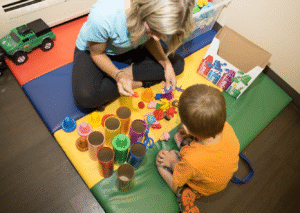The Role of Neuro Occupational Therapy in Rehabilitation
Neurological conditions—such as stroke, traumatic brain injury, multiple sclerosis, cerebral palsy, and Parkinson’s disease—can change life in an instant. They can impact movement, memory, balance, speech, and even the simplest daily tasks.
While physical therapy is essential for regaining movement and strength, there’s another piece of the recovery puzzle that is often underestimated: neuro occupational therapy. This specialized therapy focuses on translating physical gains into real-world independence, helping patients not just recover, but reclaim their lives.
At Crawl Walk Jump Run Therapy Clinic, our neuro occupational therapists combine advanced neurological knowledge with practical, hands-on strategies. The result? A therapy experience that bridges the gap between medical recovery and meaningful, everyday living.
What Is Neuro Occupational Therapy?
Neuro occupational therapy is a highly specialized branch of occupational therapy designed for individuals with neurological conditions. The goal is simple yet life-changing—help people regain independence in the activities that matter most to them. That could mean dressing without assistance, cooking a favorite meal, returning to work, or navigating the community with confidence.
It combines four key elements:
- Neuroscience: Understanding how the brain and nervous system control movement, sensation, and thought.
- Therapeutic exercises: Strengthening muscles, refining coordination, and retraining movement patterns.
- Cognitive rehabilitation: Sharpening memory, attention, problem-solving, and executive functioning skills.
- Adaptive strategies: Teaching new ways to accomplish tasks when old methods no longer work.
When these elements work together, neuro occupational therapy becomes a powerful tool for rebuilding independence.
How Neuro Occupational Therapy Bridges the Gap in Rehabilitation
From Clinic to Daily Life
Physical therapy may restore movement, but knowing how to use that movement is another challenge entirely. Neuro occupational therapy takes gains from the clinic and applies them to daily activities.
For example:
- Improved arm strength from PT becomes the ability to reach for and pour a glass of water.
- Better balance translates into safely stepping in and out of the shower.
- Increased endurance allows for longer trips to the grocery store or walks with family.
The goal is always to make sure every improvement in therapy has a direct, meaningful impact outside the clinic walls.
Motor and Cognitive Integration
Neurological conditions often affect both the body and the mind. Cooking a simple meal requires more than just the physical ability to stir or chop—it also involves remembering steps, managing timing, and staying safe in the kitchen.
A neuro occupational therapist helps patients practice tasks that require both motor and cognitive skills, creating a bridge between the brain and the body. This not only boosts independence but also builds confidence in handling real-world challenges.
Adaptive Equipment and Home Modifications
Sometimes recovery means finding new ways to do things. Neuro OTs are experts at recommending adaptive tools and modifications that make life easier, such as:
- Weighted utensils to reduce tremors while eating
- Dressing aids to simplify getting dressed
- Non-slip mats and grab bars for safety in the bathroom
- Kitchen reorganization for easier access to frequently used items
These strategies empower patients to be more self-sufficient while reducing the risk of injury.
Sensory Re-education
After a neurological injury, sensations may feel different—or may be hard to detect at all. Neuro occupational therapy includes sensory re-education techniques that help the brain relearn how to process touch, temperature, pressure, and movement.
This can improve coordination, reduce discomfort, and enhance safety—particularly in situations where accurate sensory feedback is critical, like cooking or crossing the street.
Long-Term Support and Prevention
Neurological recovery is not always a quick process. In many cases, it’s an ongoing journey that requires periodic adjustments. Neuro occupational therapists provide long-term support, teaching patients and families strategies to maintain progress, prevent secondary complications, and adapt as needs change.
For example, someone with multiple sclerosis may need different strategies in the early and later stages of the condition. Continuous guidance helps ensure they stay as independent as possible at every stage.
The Impact of Early Intervention
Research consistently shows that starting neuro occupational therapy early leads to better outcomes. The sooner the brain and body begin retraining after an injury, the more adaptable the nervous system remains.
Early intervention can:
- Prevent muscle stiffness and contractures
- Reduce the risk of learned dependence on others
- Boost confidence and motivation from seeing progress sooner
For more on early rehabilitation approaches, visit The American Occupational Therapy Association for evidence-based guidelines.
Why Choose Crawl Walk Jump Run for Neuro Occupational Therapy?
At Crawl Walk Jump Run Therapy Clinic, we believe in treating the whole person—not just the condition. Our neuro occupational therapists work side-by-side with physical therapists and speech-language pathologists, ensuring every aspect of recovery is addressed.
We tailor every program to individual goals, whether that means returning to work, playing with children, joining friends for social activities, or traveling again. We approach each patient with equal parts clinical expertise and compassionate understanding.
Contact us to schedule your free consultation. Whether you’re just beginning recovery or looking to take your progress further, our team is here to help you bridge the gap between where you are and where you want to be.




